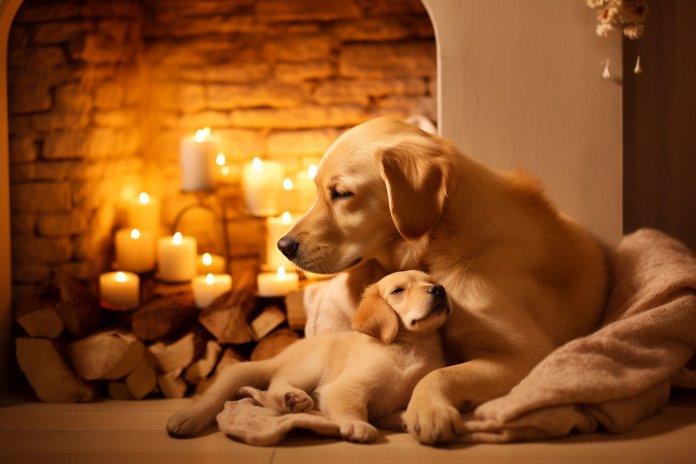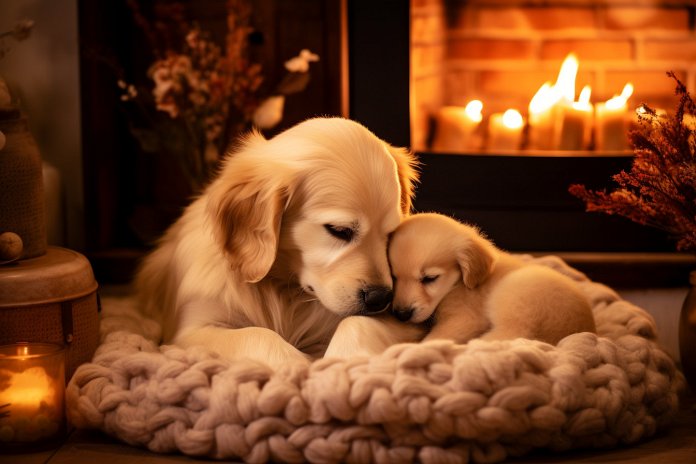
A mother’s love is timeless. There are accounts of dogs who make good mothers. One example is Jasmine, a rescued Greyhound, who cared for over 50 animals at a wildlife sanctuary. She was a mother to puppies, foxes, a fawn, badger cubs, chicks, guinea pigs, rabbits, a deer, and even a goose!
Mother Dogs and Their Pups
Mother dogs have the instincts to care for their fragile pups and teach them how to behave. However, mother dogs and their pups are usually separated after six to eight weeks. This raises the question of whether the bond between mother and pup endures over time and if a mother dog can recognize her pups later on.
Signs a Dog Remembers Their Babies
A mother dog is protective of her pups. It is her instinct to feed, groom, and keep them safe from harm. If they were in the wild, it would be her role to protect them from other animals and keep them in the den. It’s important to consider these protective instincts if your dog has pups and watch for signs of aggression towards anyone who might harm them.
Some signs to watch for include a tail that is down or between the legs, a lowered body, lowered and back ears, dilated pupils, and raised hackles. Another sign of stress is sweaty paws, similar to how we get sweaty hands when we’re distressed.
Some dog owners may notice changes in their dog’s behavior during pregnancy. Restlessness and anxiety are common during gestation, and once the puppies arrive, the mother will focus entirely on them and may ignore you. She will also be tired, so it’s best to leave her alone to rest and take care of her babies.
When the puppies are newborn, the mother will lick and groom them, stimulating them to urinate and defecate. She may also carry them by the scruff of their necks or paw at the ground to find a safe place for them.
Body Language
Signs of anxiety in a mother dog taking care of her young include sweaty paws, tail tucking, ears back, and a “whale eye” with dilated pupils. Other signs include exhaustion, staying close to the pups, pawing at the ground, licking the pups, and ignoring you.
History and Science Behind Dogs Remembering Their Babies
The memories of mother dogs are believed to be grounded in their wolf ancestry. In the wild, wolf pups would stay with their mother and pack for up to three years. Both parents would be responsible for their care and survival. While domesticated dogs have evolved, they still have the instinct to be protective of their young and form a sensory memory of their litter.
The love hormone, oxytocin, is released in mother dogs when their pups are born, just like in human mothers. This hormone strengthens the bond between mother and pups and promotes care for the young. If the right conditions are present during the first four months of a puppy’s life, the bond between mother and pup can last a lifetime.
Studies have found that mother dogs can vary in their recognition of their pups, with some showing a happy reunion and others simply moving on. However, when exposed to scents of other dogs or their own previous pups, mothers preferred the scent of their own young, suggesting they do remember them.
Caring for the Mother Through the Birth Process
During the birth process, a mother dog is in control and may not appreciate interference from humans. Provide a clean whelping box in a quiet location and allow the mother to rest and care for her young. Keep an eye out for any signs of infection and give the new family space to bond without too much external interference.
Conclusion
A mother dog’s love and care for her pups are real and lasting. Through their instincts and the release of oxytocin, mother dogs form strong bonds with their young. While their recognition of their pups may vary, studies suggest that they do remember them. Providing a safe and calm environment during the birth process is essential for the well-being of the mother and her puppies.
“Mother dogs have a lasting bond with their puppies, thanks to the power of love and instinct.”

Tips & Things to Know
1️⃣ Pay attention to the signs of a mother dog’s protective instincts. If your dog has recently given birth, watch for signs of aggressive behavior, such as a lowered tail, dilated pupils, and lowered ears. These behaviors are normal as the mother is just protecting her young.
2️⃣ Understand that a mother dog’s behavior may change during and after pregnancy. During gestation, your dog may seem more restless and anxious. Once the puppies arrive, the mother will focus all her attention on them and may ignore you. Give her space and let her rest and take care of her babies.
3️⃣ Remember that the bond between a mother dog and her pups can last a lifetime. The memories and love are grounded in the dog’s ancestral instincts and the release of oxytocin, the love hormone, during the birthing process. Time together, positive imprinting, and the age of the mother can all play a role in the mother’s ability to recognize her pups.
Frequently Asked Questions, Answered ✅
1. How does a mother dog show her protective instincts towards her pups?
– A mother dog will exhibit behaviors such as feeding, grooming, and keeping her pups from harm. She may also display aggressive behavior towards potential threats.
2. What are some signs that a mother dog is feeling anxious or inclined to be aggressive in defense of her pups?
– Signs of stress and potential aggression include a lowered tail, lowered and back ears, dilated pupils, and raised hackles. Dogs may also have sweaty paws.
3. How does a mother dog care for her newborn puppies?
– A mother dog will lick and groom her puppies, stimulate them to urinate and defecate, and may carry them by the scruff of their neck. She may also paw at the ground to create a nest and hide her pups.
4. Do mother dogs remember their puppies later on?
– It is believed that mother dogs have a sensory memory of their litter and can recognize their own pups. The bond between a mother dog and her puppies can be enduring if the right conditions are present during the early months of the puppies’ lives.
5. How can humans care for a mother dog during the birthing process?
– Provide a clean, quiet whelping box for the mother dog. Allow her to take control and provide a secure environment. Monitor for signs of infection and contact a veterinarian if necessary. Give the new family space to bond and minimize disruptions.